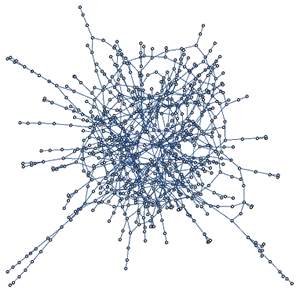From the parts to the whole in network emergence
When the gap between the two scales of interest is large enough, we are shifting from dealing with pattern inference across adjacent scales to connecting different hierarchical levels in a system. In particular, this section examines self-organized pattern emergence in bottom-up models of ecological networks. The function and architecture of ecological networks emerge from the life-history, physiological constraints and optimization of each population in the network. Specifically, the scaling pattern of hierarchy depicts how the structure and function of asymmetrical ecological systems emerge and change with the system complexity. Using ecological networks as a proxy, this section aims to investigate how cascade interactions affects the robustness and resilience of networks, how network architectures, especially nestedness and compartmentalization, emerge and function, and the role of network complexity on the stability of ecological networks.
Network complexity and stability
Forty years ago, Robert May published his iconic book, Stability and Complexity in Model Ecosystems. Using a mathematical model of differential equations, May derived an opposite conclusion to the common belief in ecology: complexity leads to instability. The endeavour to resolve May’s complexity and stability dilemma by scientists using networks as a proxy is classical ongoing example of how characteristics of the parts affect the function of the whole in ecology.
Nestedness in mutualistic networks
Mutualistic interactions are crucial processes to sustain ecosystem function and services, foster biodiversity and affect community stability. Mutualistic networks often exhibit a distinctive nested structure, with the observed level of nestedness significantly higher than that of random network generated from a variety of null models, yet still much lower than that of perfectly nested networks. It is evident that species often switch their interactive partners in real-world mutualistic networks such as pollination and seed-dispersal networks, and this adaptive behaviour can be important to the structure and stability of networks.
Compartmentalization in antagonistic networks
Antagonistic interactions, such as herbivory, parasitism and predation, are important to the provision of ecosystem function and service. It represents the process of resource exploitation in ecological networks and can divide species into clusters where consumers within a cluster are likely to share the same function and exploit similar resources. Such a clustering architecture (i.e. compartmentalization) can have profound effects on the stability of ecological communities. Specifically, compartmentalization tends to stabilize ecological networks by containing the effect of perturbations within modules. Despite their important role in securing ecosystem functions and services during perturbations, mechanisms that can account for the level of compartmentalization close to those observed in real ecological networks remain poorly understood.
Scaling metabolism from cells to ecosystems
Allometric scaling is the most salient pattern of how biological rates, especially metabolic rate, are regulated by organism size. Models based on constraints in the cardiovascular and respiratory transportation networks for multicellular organisms have yielded a simple explanation to the 3/4 power law of metabolic scaling. This has lead to a number of developments related to connecting body size to patterns of biodiversity and networks.
Coupling ecological and evolutionary scales
Ecological patterns not only emerge from scales and hierarchies, but also the coupling of fast and slow processes. This section presents the most obvious examples of coupling fast and slow processes, namely coupling processes working at ecological (fast) and evolutionary (slow) scales. The last few decades and recent development in models have allowed us to handle the coupling of ecological and evolutionary scales under the banner of frequency-dependent selection. Models in this section are designed to bridge the concurrency of ecological and evolutionary processes.
Unifying evolutionary dynamics
Evolutionary dynamics concern a few key variables: genotypes and traits of interest, the relative abundance (frequency) of specific traits, the fitness of the genotype which is defined as its replication rate and dependent on both its trait value and frequency, and finally the mutation rate. Several models are available that depict the interplay of these variables: the quasi-species equation of molecular evolution, evolutionary game theory, the replicator-mutation equation, the Price equation, adaptive dynamics, and a few unified models that synthesize all these specific models into one. A standard procedure for analyzing these models is known as the evolutionary invasion analysis, where the evolutionary singularity and selection gradient are examined with the faster ecological dynamics set at its equilibrium. Together, these models and their unified forms provide a complete description of evolutionary dynamics and behaviour under natural selection.
Rapid evolution
The impact of evolution at contemporary scales, also known as the rapid eco-evolutionary feedback, has gained momentum in literature, especially when dealing with adaptive response to global changes. This kind of rapid evolution challenges the standard approach of setting the fast ecological dynamics at equilibrium in the analysis and calls for further considering the impact in the dynamic behaviours of both traits and populations.



